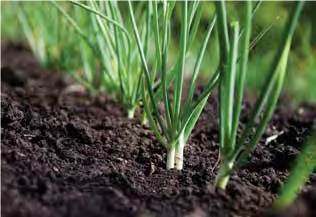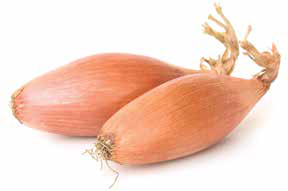Onions

Onions are cool season plants that need to be planted at specific times to have good growth. Bulbing and green onions are biennial plants that are grown as annuals in the cool, spring growing season. Other types of onions, including Egyptian walking onions, multiplier onions, and shallots are hardy perennials that are either planted as perennials (walking onions) or are planted in the fall for harvest the following summer (multiplier onions and shallots). Onions can be yellow, white, or red and vary in sweetness and pungency. Some varieties are better for long storage than others.
The most important consideration when selecting onion varieties is knowing the latitude of your location. Onion varieties are categorized into “long day,” “intermediate,” and “short day” varieties. Long day varieties develop bulbs when there are 15 to 16 hours of sunlight and are adapted for more northerly areas (latitudes 37 to 47). Intermediate day varieties perform best in latitudes 32 to 42. Short day varieties perform best in latitudes 25 to 35. This means that intermediate day varieties are best for all of Kansas, while some long day varieties may do well in the northern parts of the state. Gardeners along the southern edge of Kansas could try short day varieties as an experiment, but they likely will not produce large onions in most years. Para información en español, visite este sitio web.
 Onions are ready for harvest when the tops begin to weaken and naturally fall over. This is a signal that the bulbs are as big as they will get. Pull or dig the onions and store in a warm, dry, shaded location for 2 to 4 weeks until the tops and necks are completely dry. After the tops are dry, cut them, trim the roots, and store in a cool dry location. Onions need cool storage, but they should not be stored in a tight plastic bag. An open mesh bag is best for storage. Mild-flavored onions keep for only a month or so. Stronger flavored or more pungent onions keep 3 to 4 months.
Onions are ready for harvest when the tops begin to weaken and naturally fall over. This is a signal that the bulbs are as big as they will get. Pull or dig the onions and store in a warm, dry, shaded location for 2 to 4 weeks until the tops and necks are completely dry. After the tops are dry, cut them, trim the roots, and store in a cool dry location. Onions need cool storage, but they should not be stored in a tight plastic bag. An open mesh bag is best for storage. Mild-flavored onions keep for only a month or so. Stronger flavored or more pungent onions keep 3 to 4 months.